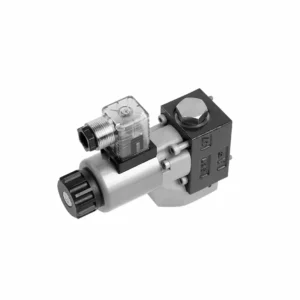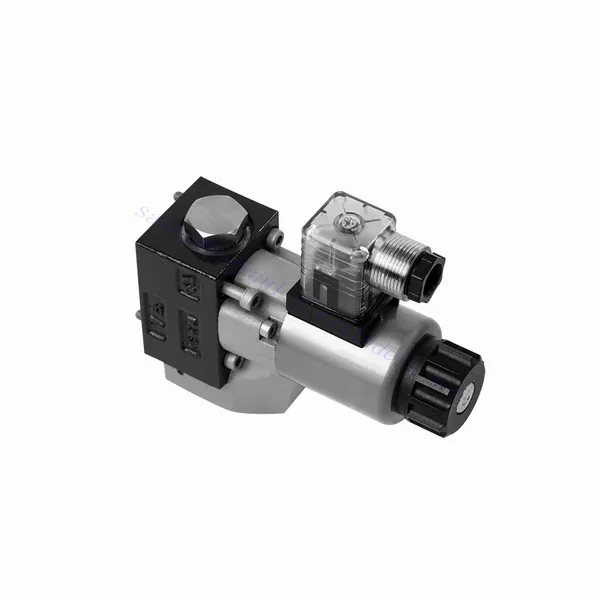M-SEW Series Directional Poppet Hydraulic Valve With Solenoid Actuation
Üheks hüdrosilindrite tootjaks, tarnijaks ja mehaaniliste toodete eksportijaks pakume hüdrosilindreid ja paljusid teisi tooteid.
Palun võtke meiega ühendust üksikasjade saamiseks.
Post:sales@hydraulic-cylinders.net
Tootja tarnija eksportija hüdrosilindrid.
M-SEW Series Directional Poppet Hydraulic Valve With Solenoid Actuation

The M-SEW series directional poppet hydraulic valve with solenoid actuation is an advanced hydraulic valve designed to provide precise control and optimal efficiency in hydraulic systems. With its innovative design, reliable performance, and integrated solenoid actuation, this valve offers enhanced fluid flow control, flexibility, and compatibility with various industrial applications.
The M-SEW series directional poppet hydraulic valve with solenoid actuation is a reliable and efficient solution for hydraulic systems. With its directional poppet design, integrated solenoid actuation, versatility, and high flow capacity, this valve offers precise control, enhanced efficiency, and compatibility with various applications. The M-SEW series valve delivers optimal performance and reliability by following the recommended usage methods and adhering to regular maintenance practices. Upgrade your hydraulic system with the m-sew series directional poppet hydraulic valve and experience enhanced control, efficiency, and productivity.
M-SEW Series Directional Poppet Hydraulic Valve With Solenoid Actuation Key Characteristics:
- Directional Poppet Design:
- The M-SEW Series Valve features a directional poppet design, ensuring reliable and efficient fluid flow control.
- It allows for quick response times and precise regulation of fluid direction, enhancing overall system performance.
- Solenoid Actuation:
- Equipped with integrated solenoid actuation, this hydraulic valve provides remote and automated control capabilities.
- The solenoid allows quick and accurate switching between different flow paths, improving operational efficiency.
- Versatility and Compatibility:
- The M-SEW Series Valve is highly versatile and compatible with various hydraulic systems and applications.
- It can be seamlessly integrated into industrial machinery, mobile equipment, and automation systems, enhancing performance.
- High Flow Capacity:
- With its robust design and optimized flow paths, the M-SEW Series Valve offers high flow capacity.
- It ensures efficient fluid transfer, reducing pressure drops and maximizing system throughput.
M-SEW Series Directional Poppet Hydraulic Valve With Solenoid Actuation Parameter:
| Specifications | NG6 | NG10 | ||
| Installation position | Optional | |||
| Environment temperature | ℃ | -30 to +50 (NBR seals) | ||
| -20 to +50 (FKM seals) | ||||
| Weight | Two two-way solenoidic directional valve | Kg | 1.5 | / |
| Two three-way solenoidic directional valve | Kg | 1.5 | 2.0 | |
| Two four-way solenoidic directional valve | Kg | 2.3 | 3.5 | |
| Max. operating pressure | Port P A B | bar | 420 | 420 |
| Port T | 100 | 100 | ||
| Max. flow-rate | L/min | 25 | 40 | |
| Fluid | Mineral oil suitable for NBR and FKM seal | |||
| Phosphate ester for FKM seal | ||||
| Fluid temperature range | ℃ | -30 to +50 (NBR seals) | ||
| -20 to +50 (FKM seals) | ||||
| Viscosity range | mm2/s | 2.8 to 500 | ||
| Degree of contamination | Maximum permissible degree of fluid contamination: Class 9. NAS 1638 or 20/18/15, ISO4406 | |||
M-SEW Series Directional Poppet Hydraulic Valve With Solenoid Actuation Advantages:
• Direct solenoid shutoff valve
• Installation face follow DIN 24340 A, ISO 4401 and CETOP-RP 121H
• No leak
• Responsive switching under high pressure
• Replacing the coil can be performed with pressure
• Solenoid coil can rotate 90°
• With manual emergency control
Usage Method Of M-SEW Series Directional Poppet Hydraulic Valve With Solenoid Actuation:
- System Assessment:
- Conduct a thorough assessment of the hydraulic system to determine the specific requirements and operational parameters.
- Consider factors such as flow rates, pressure ratings, and compatibility with the M-SEW series valve.
- Valve Selection:
- Select the appropriate M-SEW series valve variant based on the system requirements and specifications.
- Consider port size, voltage compatibility, and solenoid actuation parameters.
- Installation:
- Follow the manufacturer’s instructions for properly installing the M-SEW series valve in the hydraulic system.
- Ensure secure mounting, proper alignment, and appropriate sealing to prevent leaks and ensure optimal performance.
- Electrical Connections:
- Connect the solenoid actuation wires to a suitable power source, following the recommended wiring guidelines.
- Ensure proper polarity and insulation to prevent electrical malfunctions or safety hazards.
How Does A Hydraulic Directional Control Valve Work?
A hydraulic directional control valve is a fundamental component in hydraulic systems that regulates the flow and direction of hydraulic fluid. It enables the operator to control the movement and operation of hydraulic actuators, such as cylinders and hydraulic motors. The directional control valve determines the path that the hydraulic fluid takes within the system, allowing it to flow in specific directions and perform desired actions. Here’s a breakdown of how a hydraulic directional control valve works:
- Valve Structure:
- A hydraulic directional control valve typically consists of a body with multiple ports, spools, or poppets and actuators such as manual levers, solenoids, or pilot pressure mechanisms.
- The valve body contains various internal passages and chambers that direct the flow of hydraulic fluid.
- Fluid Flow Paths:
- The directional control valve has multiple ports that connect to different hydraulic components in the system, such as the pump, reservoir, actuators, and other valves.
- These ports include an inlet, outlet, and work ports, each serving a specific purpose in controlling the fluid flow.
- Spools or Poppets:
- The valve body houses spools or poppets, which are movable elements that control the flow of hydraulic fluid.
- Spools are cylindrical and slide within the valve body, while poppets are spring-loaded valves that open or close based on pressure differentials.
- Actuation Mechanisms:
- Depending on the specific design and application requirement, hydraulic directional control valves can be actuated manually, electrically, or hydraulically.
- Manual actuation involves levers or handles that the operator physically moves to position the spools or poppets.
- Electrical actuation utilizes solenoids that receive electrical signals to shift the spools or poppets, allowing for remote control and automation.
- Hydraulic actuation employs pilot pressure to move the spools or poppets, often in conjunction with electrical or manual control.
- Valve Positions:
- Depending on the valve design, there are typically multiple positions that the spools or poppets can assume, each corresponding to a specific flow path.
- Common positions include neutral, which blocks or isolates all ports, and various actuating positions that allow flow between specific ports.
- As the spools or poppets shift, they align with specific ports, opening or closing passages and directing the hydraulic fluid accordingly.
- Operator Input:
- The operator engages the directional control valve by actuating the manual lever, applying electrical signals to solenoids, or manipulating pilot pressure.
- This input determines the desired valve position, which in turn determines the flow direction and the action of the hydraulic actuators.
- System Operation:
- Once the directional control valve is in the desired position, hydraulic fluid flows through the appropriate passages and ports.
- This flow of fluid powers the hydraulic actuators, such as cylinders or hydraulic motors, causing them to move or perform the intended task.
Tehase võimekus ja suutlikkus:
(1) Kokkupanek
Meil on esmaklassiline sõltumatu teadus- ja arendustegevuse montaažiplatvorm. Hüdrosilindrite tootmistöökojas on neli poolautomaatset tõstesilindrite koosteliini ja üks automaatne kallutussilindrite koosteliin, mille kavandatud aastane tootmisvõimsus on 1 miljon tükki. Spetsiaalsete silindrite töökoda on varustatud erinevate spetsifikatsioonidega poolautomaatse puhastusmontaažisüsteemiga, mille kavandatud aastane tootmisvõimsus on 200 000 ja mis on varustatud kuulsate CNC-töötlemisseadmete, mehaanilise töötlemise keskuse, suure täpsusega silindrite töötlemise eriseadmete, robotkeevitusmasina, automaatse puhastusmasina, automaatse silindri kokkupanemise masina ja automaatse värvimise tootmisliiniga. Olemasolevad kriitilised seadmed rohkem kui 300 komplekti (komplekti). Seadmete ressursside optimaalne jaotamine ja tõhus kasutamine tagavad toodete täpsusnõuded ja vastavad toodete kvaliteedinõuetele.


(2) Töötlemine
Töödeldav töökoda on varustatud kohandatud kallutatud rööpse treipingi keskuse, mehaanilise keskuse, kiire lihvimismasina, keevitusroboti ja muude seotud seadmetega, mis suudavad töödelda silindritorusid, mille maksimaalne siseläbimõõt on 400 mm ja maksimaalne pikkus on 6 meetrit.

(3) Keevitamine

(4) Värvimine ja katmine
Väikese ja keskmise suurusega silindri automaatse veepõhise värvipinnakattega liinide abil, et saavutada automaatne robotlaadimine ja mahalaadimine ning automaatne pihustamine, projekteerimisvõimsus 4000 tükki vahetuse kohta;
Meil on ka poolautomaatne suurte balloonide värvimise tootmisliin, mis töötab jõukettaga ja mille projekteerimisvõimsus on 60 kasti ühe vahetuse kohta.


(5) Testimine
Meil on esmaklassilised kontrolliseadmed ja katsestendid, et tagada silindri jõudlus vastavus nõuetele.

We are one of the best hydraulic cylinder manufacturers. We can offer comprehensive hydraulic cylinders. We also provide corresponding põllumajanduslikud käigukastid. Oleme eksportinud oma tooteid klientidele üle maailma ja teeninud hea maine tänu meie suurepärasele tootekvaliteedile ja müügijärgsele teenindusele. Me tervitame kliente kodus ja välismaal, et võtta meiega ühendust, et pidada läbirääkimisi äri, vahetada teavet ja teha meiega koostööd!
Tehke ekskursioon meie VR-tehases:
Tehke ekskursioon meie VR-tehases koos järgmisega
Hüdrosilindri kasutamine:


